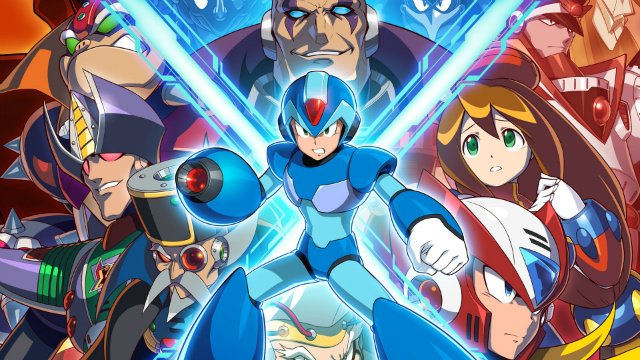Mega Man X is like Mega Man‘s cooler older brother. When you were a kid, you thought that he was cool because he smoked and drove a Camaro. He was always pretty good to you, even if he acted tough. But, as you grew older and matured, he kind of kept doing the same thing. Eventually, you realized that smoking is terrible for you and that Camaro he had wasn’t even a Z28, it was a base model V6. Finally, you moved on, and even though you think back fondly on Mega Man X, revisiting your best memories of it often, you try not to think about what became of it.
Mega Man X Legacy Collection 1+2 brings the good and the bad of the series to current-gen consoles and PC. The last Mega Man X game, Mega Man X8, was released in 2004. Beyond the 2006 collection of Mega Man X-X6 for GameCube and PlayStation 2, Mega Man X Collection, nothing new has been done with the series in 14 years. However, someone at Capcom (presumably the same person who gave the green light to the Resident Evil 2 remake) realized that people really do like their classic franchises and so we get this enhanced and revamped collection of the whole series.
Mega Man X Legacy Collection 1+2 Review: The New Stuff
The Mega Man X Legacy Collection contains what you’re used to in a retro game collection. The graphics have been filtered and/or upscaled to look good in HD. This is especially noticeable in the SNES entries, but even the PS and PS2 entries are noticeably better looking on a flatscreen than they usually would be. This is a godsend for anyone who doesn’t want to mess with emulators to get decent visuals.
The collection also contains a Museum with a ton of character design artwork, toy galleries, trading card galleries, and more. You can also check out the music for each game with a music player. One thing that is missing, though, which is especially noticeable concerning the PS and PS2 games, is a cutscene viewer. There’s some pretty cool anime-style animation included in some of the games that would have been neat to watch on demand.
Both collections also contain a new X Challenge mode where you can take on two Mavericks at the same time. There’s also a mode for each game that dramatically reduces the difficulty for those who are new to the series or longtime fans that just want to have a quick run through without any stress.
Another cool option that is included is the ability to change between the English and Japanese version of each Mega Man X game. Some entries also include other international versions. Since these games don’t really take a lot of reading or listening to play, this is a neat way to see the different translations and still enjoy the gameplay. However, there are is a game in the collection I wish they would have included more version options for which I will explain in its specific entries below.
Mega Man X Legacy Collection 1 Review: The Good Stuff
Since this is technically two individually purchasable collections (which you can also buy together), I’ll cover each separately here. The games contained in Mega Man X Legacy Collection 1 are the biggest attraction here. You get the SNES versions of Mega Man X, Mega Man X2, and Mega Man X3, as well as the PlayStation version of Mega Man X4. These four games were by far the best and most innovative entries in the series, and we’ll examine them in further detail below.
Mega Man X Legacy Collection 1 Review: Mega Man X (1993)
This is where the series began and was the title most influenced by then Lead Artist Keiji Inafune. Some players hold the sentiment that the entries after Mega Man X never topped the original, and there’s a reason why. Mega Man X was exquisitely designed and feels like the natural evolution of the Mega Man franchise. It showed the leap over the NES that the SNES provided, with a maturation and depth that was leaps over the original Mega Man games.
Mega Man X keeps much of the same gameplay style as Mega Man introduced, but refines it and adds its own signature elements. Upgrade capsules and ride armor make their premiere here, as do the anthropomorphic Maverick bosses. We also meet Sigma for the first time, who, unlike Dr. Wily, was portrayed as being purely maniacal and threatening instead of providing occasional comic relief (though Wily does make some sinister appearances in the X series).
Mega Man X is the best point to start if you’ve never played the series before and is definitely one of the top games in the franchise.
Mega Man X Legacy Collection 1 Review: Mega Man X2 (1994)
Mega Man X2 follows closely in the original’s footsteps. All the same, elements are present with some newly added things. Vehicles play a more prominent role, and you’ll take the helm of Ride Armor and new attack hoverbikes.
In addition to the eight Mavericks, you’ll need to defeat, there is a new group called the X-Hunters you can optionally takedown. They move between the eight stages, and if you track them down and beat them, each one will give you a piece of Zero. If you collect all three parts, you’ll get a better ending, making this the first entry in the Mega Man franchise to have multiple endings.
Mega Man X Legacy Collection 1 Review: Mega Man X3 (1995)
Mega Man X3 is one of those games that came out late in the life of the SNES that is worth its weight in gold. Not many copies were produced, and like Mega Man X2 it uses the Cx4 chip to draw wireframes. This custom chip means that the aftermarket hasn’t been flooded with a ton of repro carts.
Mega Man X3 just takes the formula of Mega Man X even further. This time around there’s four different kinds of Ride Armor that can be summoned at special pads. Before you can summon them, though, you’ll need to unlock them by finding items hidden within the stages. In turn, some power-ups can only be found by using a specific Ride Armor.
This is also the first game in the Mega Man X series to let players switch between X and Zero in almost every location in the game.
One thing I wish Capcom would have done with the Mega Man Legacy Collection is to have included the PlayStation/Saturn version of Mega Man X3. We get the SNES version, which is excellent, but the PlayStation and Saturn editions got a full CD quality soundtrack and animated cutscenes. Two particularly great songs, “One More Time,” and “I’m Believer,” by Kotono Shibuya are missing since they’re exclusive to the PS1 and Saturn versions and that’s a damn shame.
Mega Man X Legacy Collection 1 Review: Mega Man X4 (1997)
This game marks the leap to PlayStation on Saturn. Instead of just being a port to those systems like X3, Mega Man X4 was built from the ground up for fifth-generation consoles. The gameplay remains much the same as the first three games. The graphics still consist of sprites, but they’re more complex and fluid, drawing on the more powerful hardware of the PS1 and Saturn.
The significant new addition that came with Mega Man X4 was that Zero became a fully playable character. While you could call him in as X in X3, you couldn’t actually play through the whole game as him. This time around though he’s a full character with his own power-ups and unique weapon, the Z-Saber.
The story in Mega Man X4 is also more complicated than the ones portrayed in X-X3. It’s not a magnum opus, but the new characters and animated cutscenes lend some fun flavor and context to the robot busting action.
Mega Man X Legacy Collection 2 Review
Mega Man X Legacy Collection 2 contains Mega Man X5 through Mega Man X8. These games aren’t nearly as strong as the first four, and one of them, Mega Man X7, is actually just pretty bad. However, if you’re a big fan of the franchise, there’s plenty of reasons to check out the second half of the series.
Mega Man X Legacy Collection 2 Review: Mega Man X5 (2000)
Mega Man X5 was initially meant to be the last in the series, and Inafune had little to do with production. It’s more of the same gameplay as the first four. Zero and X are no longer separate characters and can now be freely switched between. X gets four armors in this game, and Zero can even get a different armor if you search hard enough.
New to X5 is the virus system. Sigma has spread a Maverick Virus (again), and both Zero and X can accumulate viruses. If X is too severely infected, he will eventually enter a state where he loses health constantly. On the flip side, if Zero is infected, he’ll become invincible and have increased attack power. There are also multiple endings and paths in this game, which adds a bit of choice on how to approach the endgame.
Mega Man X Legacy Collection 2 Review: Mega Man X6 (2001)
This is where the series started getting a bit weird. Mega Man X6 centers around the Nightmare Virus and the Zero Nightmare. In my opinion, the game gets much to complex this time around. There is an emphasis on rescuing Reploids and a new parts system that allows you to attach modifiers to characters.
The graphics are a bit of a downgrade in comparison to X5, and the tight development cycle X6 had makes it feel a bit generic in places. However, at its core, X6 is still Mega Man, and it’s worth a playthrough for fans of the series. It’s also the last of the Mega Man X games to use sprites for the graphics.
Mega Man X Legacy Collection 2 Review: Mega Man X7 (2003)
Mega Man X7 is the worst entry in the series. Capcom must have taken reviews of X6 to heart, and complaints that the franchise had stagnated resulted in a complete overhaul for X7. The result was a mixture of 2D and 3D gameplay that didn’t satisfy the Mega Man old guard or those clamoring for innovation.
Sigma is back in X7, yadda, yadda, yadda. There is a new character in the form of Axl, though. Mega Man X has retired because he’s tired of fighting. He’s become a bit of a whinger in the meantime and is generally unlikeable.
The gameplay is just not great. There’s a pretty poor lock-on system that just doesn’t work as it should, and the gameplay as a whole suffers terribly as a result of the transition to 3D. Unfortunately, the 3D gameplay influences the 2D sections as well, and that tight control and fast-paced shooting the series is known for just isn’t here.
Also, the graphics have gone from beautiful (or at least decent-looking) sprites to the same generic, undetailed polygonal forms that ran rampant in the days of the PlayStation 2.
Mega Man X Legacy Collection 2 Review: Mega Man X8 (2004)
The last game in the Mega Man X series is, fortunately, a lot better than X7. Mega Man X8 keeps the “2.5D” style of its predecessor, but ditches 3D gameplay for all except to stages. The camera and controls have been much improved as well.
As the culmination of the X series, X8 is a bit lacking, but it’s definitely more engaging than X7. The story gets some lousy anime-trope vibes going on, though, and there’s no real resolution to the story except that maybe this time Sigma is gone for good.
Mega Man X Legacy Collection 1+2 Review: Eight Games, Some Good, Some Mediocre
The Mega Man X series is odd. On the one hand, the first four had some of the best platforming gameplay I’ve ever played. On the other hand, the last two entries in the series are pretty rough, with X7 bordering on bad. However, I do recommend the series as a whole. Mega Man X Legacy Collection 1+2 can be bought for $19.99 separately or $39.99 as a pair, and I feel like that’s a fair price for all eight games.
The enhancements and bonus features make this the definitive collection of the Mega Man X series, especially since Mega Man X Collection is 12 years old and suffered from terrible slowdown. I’ve always liked Mega Man X better than Mega Man personally, and though the latter half of the series has its weaknesses, I still loved playing through them for review. Even X7, which I really remember disliking, wasn’t absolutely horrible. This is another retro collection that does an excellent job of preserving a classic franchise in an accessible form on current-gen platforms and is worth your attention whether you’re a long-time fan or someone who’s looking to get into the Mega Man X series for the first time.
Mega Man X Legacy Collection 1+2 was reviewed via a digital code provided by the publisher.
-
Man, those first four games are really good.
-
Graphical enhancements have each of the eight games looking better than ever.
-
Museum and music player are great for enjoying artwork and visuals from the game.
-
At $40, you're only paying $5 a game.
-
Mega Man X3 is the SNES version instead of the enhanced PlayStation port.
-
Mega Man X7 still sucks.











